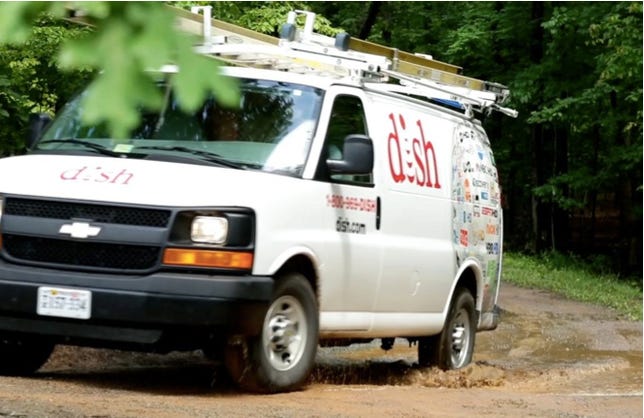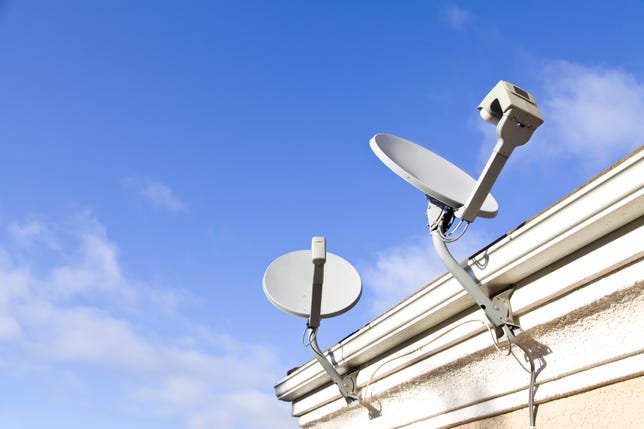Dish, once again, demonstrated that it is serious about the wireless business. But just what that business is remains to be seen.

Dish Network
The nation’s second-largest satellite TV provider was a surprise winner of the Federal Communications Commission’s so-called AWS-3 wireless spectrum auction, which concluded Thursday and generated a record-breaking $45 billion. Dish, which bid with several partners including BlackRock, spent $13.3 billion, although it qualified for some FCC credits that lowered its actual payment to about $10 billion. That’s only behind AT&T, which was the top bidder after spending $18.2 billion.
Dish’s aggressive bid, which exceeded Wall Street expectations, raises the question of what it will do with all of that spectrum, which will join an already unused stockpile that the company is sitting on. For wireless carriers such as AT&T and Verizon, which came in third in the auction with $10.4 billion in bids, the spectrum is a critical resource to be used to ensure that traffic runs smoothly over its wireless networks.
AT&T and Verizon, which already control more than 70 percent of the wireless market, need the spectrum to keep up with demand for more bandwidth-heavy applications on their networks like streaming video. But it was unclear from the start whether Dish, which does not operate a wireless network, would be a serious bidder.
“Everyone wants to know whether Dish was bidding to win or just bidding to raise prices (or even not bidding at all),” equities analyst Craig Moffett from MoffettNathanson said in a research note to investors on January 15.
While Dish isn’t in the wireless service business, Chairman Charlie Ergen hasn’t kept secret his desire to expand into the area. The company has amassed more than 45 megahertz of wireless spectrum over the past few years in various auctions and through private deals. The company, which currently provides satellite TV service, has talked about getting into the wireless broadband market with a service to rival the major wireless companies. But so far, it hasn’t made a major move other than amassing more spectrum assets.


Getty Images
In 2013, the company made a bid for Sprint, but lost out to SoftBank, which ended up buying the company for $21.6 billion. There has been talk the company may partner with or even try to buy other wireless providers, like T-Mobile. But so far no firm plans have been laid. The satellite TV provider may also try to use the spectrum on its own to build a wireless broadband service that could provide an alternative to DSL or cable broadband in parts of the country that lack broadband infrastructure.
The company, however, won’t be able to sit on the spectrum forever.
“Eventually, Dish will have to deploy the spectrum it holds or sell to a field of bidders,” said Mark Stodden, an analyst at Moody’s.
Dish aggressively pursued spectrum in the auction. It won 700 of the more than 1,600 licenses offered through the auction, beating Verizon for licenses in several big markets, including New York, Chicago and Boston.
Dish declined to comment on the recent auction or its plans for the spectrum, saying in a statement that it is prohibited from disclosing information due to the anti-collusion rules imposed by the FCC.
“The auction’s success is a win for the FCC, the American taxpayer, the public safety community and small business,” Dish said in its statement.
Three of the nation’s largest wireless companies bid on and won licenses in the auction. AT&T won 251 licenses, Verizon won 181 licenses and T-Mobile spent $1.8 billion for 151 licenses. Sprint did not participate in the auction.
The FCC, which started the auction on November 13, had set a goal of raising at least $10.6 billion for the sale of 1,600 licenses. But it became clear early in the bidding process that this goal would be surpassed.
Dish helped propel the auction beyond expectations for how much revenue the auction would generate for the government. The last major wireless auction the FCC held was in 2008 when it sold unused TV airwaves in the 700MHz band for $19.1 billion. That band went on to become the basis for Verizon and AT&T’s 4G LTE networks.
The 700MHz spectrum sold in the 2008 auction was considered beachfront property because its low frequency allows for wireless signals to travel longer distances and penetrate obstacles like walls, providing excellent network coverage inside and outside.
The AWS-3 auction covered what’s considered midband spectrum, sitting between the 1700MHz and 2100MHz frequencies. This type of spectrum is not considered as valuable as low-band spectrum, such as the TV broadcast spectrum, because signals travel shorter distances than over lower-frequency spectrum. For this reason, the record-breaking revenue raised for this auction has surprised many experts.
It also bodes well for the incentive spectrum auction, which will put up for sale TV spectrum in the 600MHz band. The auction is set for 2016.



